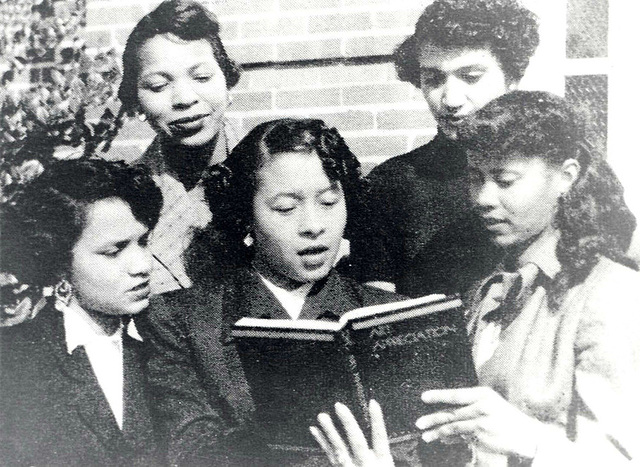Future Leaders
Elizabeth Proctor Thomas
Odessa Madre: The 'Al Capone' of DC
Silent Witnesses
Headline: Acquittal of the Negress Minnie Gaines…
Separate But Equal
Christina Moody
Servants of the White House
Emma Merritt
Market Fare
Miss Bessie Crocker
Photo Op
3rd Precinct of the Washington Police Department
An Underdown Establishment
Streetcar
Theatrical Troupe
Bali Award Winner of 1947: Sarah Vaughan
At the HU
Wake-Robin Golf Club
Lois K. Alexander-Lane
The Spurlocks
Amanda V. Gray
Howard Hall
Omega Sweetheart
The Graduate
A Teacher and her Pupils
Ella Fitzgerald
Howlin the Blues
Lady in Sepia
1st African American to Reach No. 1 on the Billboa…
B'More's First Lady of Jazz: Ethel Ennis
Lady Day
This Jazz Artist Was Included in the Holocaust Mem…
Lorraine Glover and Her Hubby's Horn
Pee Wee Marquette
Carline Ray
Eddie James 'Son' House, Jr.
Dolphy and Coltrane
The Tragic Teen Queens: Betty and Rosie Collins
Sidney Bechet and the Jazz Kings
Marion 'Little Walter' Jacobs
Sonny Rollins
Bill Broonzy
This is Louis
Sylvia Robinson
See also...
Authorizations, license
-
Visible by: Everyone -
All rights reserved
-
8 visits
Reading Group


An unknown group of young African American women pose for a photo at Fayetteville State University.
In 1867, several years after the Civil War, seven male African Americans gathered in Fayetteville to discuss opening a school for educating the future black race. The men organized into a board of trustees, and they gathered $140 dollars for two lots of Fayetteville’s Gillespie Street. General O. O. Howard donated funds to construct the first education facility on the new lots. The school became known as the Howard School, in honor of its benefactor.
The North Carolina General Assembly passed a charter for a black teacher training school in 1877. Recognizing the success of the Howard School, the legislature selected the institution and changed to the State Colored Normal School. The first state-supported school for African Americans, the Fayetteville institution was presided over by Charles W. Chestnutt from 1880 until 1883. After his retirement, Chestnutt became a successful writer, and one of his major works was The Wife of Frederick Douglass.
The young Dr. E. E. Smith, an alumnus of Shaw University, became the principal of the school in 1883, and served until 1888, and again from 1895 to 1933. During his tenure at the State Colored Normal School, Dr. Smith served as President Grover Clevelend’s Minister of the United States to Liberia and he established North Carolina’s first newspaper for African Americans, The Carolina Enterprise. Yet, he remained a vital leader to the Fayetteville institution. Smith donated some 90 acres to the school, and in 1907 the school relocated to Murchison Road.
In May 1937, the State Colored Normal School became a four-year college, offering an elementary education degree to its students. Two years later, the school became the Fayetteville State Teachers College. The college grew in the 1940s and 1950s, and eventually programs other than teaching were added to curricula. In 1963, due to its addition of undergraduate programs, the school became Fayetteville State College after its physical plant expansion.
More students enrolled in Fayetteville State, and in 1969 it became Fayetteville State University (FSU).
Info: "Fayetteville State University.” William S. Powell, ed. Encyclopedia of North Carolina (University of North Carolina Press: Chapel Hill, NC 2006), Fayetteville State University
In 1867, several years after the Civil War, seven male African Americans gathered in Fayetteville to discuss opening a school for educating the future black race. The men organized into a board of trustees, and they gathered $140 dollars for two lots of Fayetteville’s Gillespie Street. General O. O. Howard donated funds to construct the first education facility on the new lots. The school became known as the Howard School, in honor of its benefactor.
The North Carolina General Assembly passed a charter for a black teacher training school in 1877. Recognizing the success of the Howard School, the legislature selected the institution and changed to the State Colored Normal School. The first state-supported school for African Americans, the Fayetteville institution was presided over by Charles W. Chestnutt from 1880 until 1883. After his retirement, Chestnutt became a successful writer, and one of his major works was The Wife of Frederick Douglass.
The young Dr. E. E. Smith, an alumnus of Shaw University, became the principal of the school in 1883, and served until 1888, and again from 1895 to 1933. During his tenure at the State Colored Normal School, Dr. Smith served as President Grover Clevelend’s Minister of the United States to Liberia and he established North Carolina’s first newspaper for African Americans, The Carolina Enterprise. Yet, he remained a vital leader to the Fayetteville institution. Smith donated some 90 acres to the school, and in 1907 the school relocated to Murchison Road.
In May 1937, the State Colored Normal School became a four-year college, offering an elementary education degree to its students. Two years later, the school became the Fayetteville State Teachers College. The college grew in the 1940s and 1950s, and eventually programs other than teaching were added to curricula. In 1963, due to its addition of undergraduate programs, the school became Fayetteville State College after its physical plant expansion.
More students enrolled in Fayetteville State, and in 1969 it became Fayetteville State University (FSU).
Info: "Fayetteville State University.” William S. Powell, ed. Encyclopedia of North Carolina (University of North Carolina Press: Chapel Hill, NC 2006), Fayetteville State University
- Keyboard shortcuts:
Jump to top
RSS feed- Latest comments - Subscribe to the comment feeds of this photo
- ipernity © 2007-2024
- Help & Contact
|
Club news
|
About ipernity
|
History |
ipernity Club & Prices |
Guide of good conduct
Donate | Group guidelines | Privacy policy | Terms of use | Statutes | In memoria -
Facebook
Twitter
